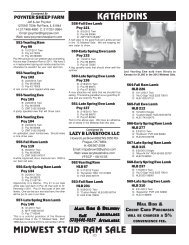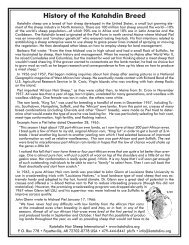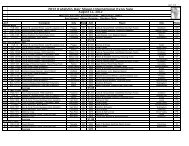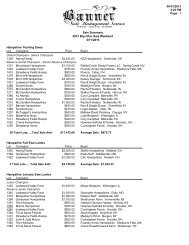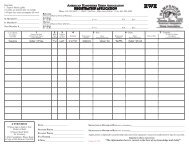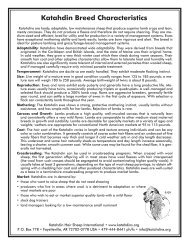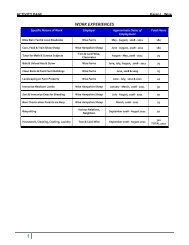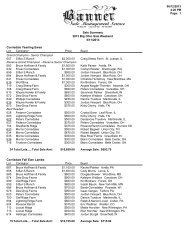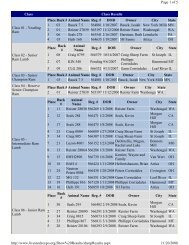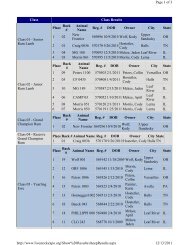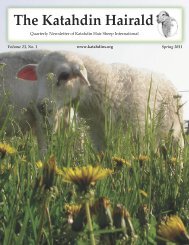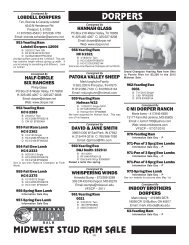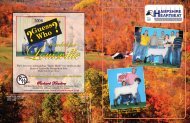KHSI Hairald Summer 2007
KHSI Hairald Summer 2007
KHSI Hairald Summer 2007
Create successful ePaper yourself
Turn your PDF publications into a flip-book with our unique Google optimized e-Paper software.
Rotational Grazing and Managing Gastrointestinal Worm Parasites in Sheep<br />
By James Morgan, Arkansas Katahdin<br />
Producer<br />
Editor’s Note – A similar version of<br />
this article was previously published in<br />
The Shepherd Magazine.<br />
In most parts of the US, the significant<br />
parasite for sheep is the barber<br />
pole worm, Haemonchus contortus,<br />
which causes productivity losses<br />
and mortality when grazing sheep<br />
in moderate to high densities. Risk<br />
is greatest in young animals and<br />
lactating ewes grazing pastures in<br />
mid to late summer when numbers<br />
of worm larvae are high.<br />
Recently several producers have<br />
mentioned that they needed to<br />
switch to rotational to solve nematode<br />
worm problems in their sheep<br />
or goats. So, does rotational grazing<br />
decrease parasite load in sheep?<br />
Definitive research demonstrating<br />
effects of rotational grazing on levels<br />
of parasitism in sheep has not been<br />
done. It is hard to design an experi-<br />
<br />
<br />
<br />
<br />
<br />
<br />
<br />
<br />
<br />
<br />
<br />
<br />
<br />
<br />
<br />
<br />
<br />
<br />
<br />
<br />
<br />
<br />
<br />
ment where groups of continuously<br />
grazing sheep and rotationally grazing<br />
sheep receive similar treatments.<br />
If nutrition and management are the<br />
same, then differences in level of<br />
parasitism between the groups can<br />
be attributed to the type of grazing<br />
system and not to other factors. In<br />
the absence of research we can look<br />
at the biology of the worm and predict<br />
if rotational grazing can reduce<br />
barber pole worm losses.<br />
Rotational grazing alone will not<br />
eliminate parasite risks. Just knowing<br />
the time it takes for larvae to<br />
hatch and develop to the infective<br />
stage suggests that the risk remains<br />
high for most rotational grazing<br />
systems. Worm larvae hatch and<br />
are available for ingestion approximately<br />
2 weeks after the eggs are<br />
deposited in the feces on pasture if<br />
sufficient moisture is present. These<br />
larvae will survive for several weeks<br />
or sometimes months if moisture is<br />
sufficient. For most rotationally<br />
grazed pasture<br />
systems and<br />
weather condi-<br />
<br />
tions, maximizing<br />
quality<br />
and/or quantity<br />
of forage<br />
requires that the<br />
grazing flock be<br />
rotated back<br />
over the same<br />
paddock every<br />
15-35 days. This<br />
Round Mountain<br />
Katahdins<br />
Performance-Based Selection on Pasture<br />
Selecting for stock with balanced EPDs<br />
and superior Lbs Lamb Weaned<br />
Jim Morgan & Teresa Maurer<br />
NW AR • 479-444-6075<br />
jlmm@earthlink.net<br />
rotational grazing frequency is predicted<br />
by many parasitologists to be<br />
optimal for ingestion of large numbers<br />
of worm larvae by the sheep.<br />
During the grazing season, each<br />
rotation of the sheep through the<br />
paddock at intervals of 15-35 days<br />
will lead to increasing numbers of<br />
larvae available for ingestion. This<br />
repeated cycle leads to continually<br />
increasing numbers of worms in the<br />
sheep and potentially death:<br />
a) ingestion of larvae,<br />
b) maturation of more adult<br />
worms in the abomasum,<br />
c) resulting in more eggs passing<br />
into the feces and<br />
d) higher numbers of worm larvae<br />
in the forage.<br />
A key purpose of most rotational<br />
grazing or management intensive<br />
grazing (MIG) programs is to<br />
regulate where and when grazing<br />
occurs. Decreased parasite load<br />
can be a goal of controlled grazing.<br />
Parasitologists have found that 80-<br />
90% of the nematode larvae do not<br />
move more than 2–2.5 inches above<br />
the soil surface. Managing grazing<br />
to minimize sheep eating close to<br />
the ground will reduce worm larvae<br />
ingestion. Preventing sheep<br />
from grazing close to the ground<br />
is easier said than done, since the<br />
shorter forage is typically more<br />
palatable and preferred. Typically,<br />
minimizing the amount of forage<br />
CONTINUED ON PAGE 14<br />
check out our Breeder Page<br />
at www.khsi.org<br />
NSIP, SFCP<br />
certified scrapie free<br />
SUMMER <strong>2007</strong><br />
The Katahdin <strong>Hairald</strong> • www.<strong>KHSI</strong>.org Page 13



